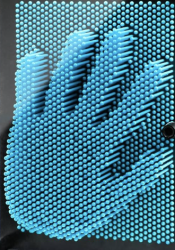A – Our product is a low cost alternative to other motorized pin displays. Our low cost and modular approach enables accessibility that can be sourced internationally, allowing replication in museums worldwide. This open and scalable approach encourages cross cultural collaboration in art installations. The ease of use enables users who are not well versed in technology.
B – LivePin is designed with sensitivity to cultural diversity and inclusivity in communication and collaboration. As an interactive system for museums and for children/adults, the device enables users to communicate three-dimensional ideas without reliance on a shared language or cultural context. This visualization system reduces the potential for misinterpretation of visual or linguistic descriptions and promotes equality regardless of language proficiency. Moreover, by enabling hands-on, physical interaction with digital content, LivePin aligns with cultures that value craftsmanship and learning. The design also respects differing cultural expectations of professional communication by providing a neutral, technology-driven medium for expression and art.
C- Our solution addresses the need for rapid, tangible 3D visualization in classrooms and small exhibits without generating one-off physical waste. Instead of printing and discarding plastic prototypes for every iteration, the system renders forms on a reusable pin board, then resets for the next concept. This directly reduces consumables (no filament, supports, or failed prints) and cuts the time and material tied up in single-use models, while still giving viewers a clear, physical sense of shape and depth.
Environmental considerations are built into the design. The frame uses durable, recyclable aluminum. The guide plates are laser-cut for low scrap, and the pins are wooden dowels that are inexpensive, repairable, and biodegradable. During operation, staged actuation keeps power draw modest relative to continuous additive manufacturing, and the system produces no consumable byproducts once a visualization is complete, the board simply resets. Taken together, the design conserves materials, lowers operational waste, and supports responsible end-of-life handling through reuse and recyclability.
A was written by Crystal. B was written by Tedd J. C was written by Safiya

